|
WEAPONS
The Priest-Kings have enforced certain Weapon Laws on
Gor. These laws limit the type of arms and armor that Goreans may use or
invent. Except for the shield and helmet, no other forms of armor are permitted.
There is no chain mail, plate armor or even leather armor on Gor. The leathers
worn by tarnsmen and others is not a form of armor. It is more akin to heavy
clothing than actual armor and is meant to protect your body from your mount.
No weapon more powerful than the lance and crossbow is permitted. Firearms,
gunpowder, tasers, stun guns and similar technological weapons are forbidden
on Gor.
The Priest-Kings have numerous space ships that constantly scan the surface
of Gor seeking violations of the Weapon Laws. They also have numerous human
agents who keep them informed about what is happening. A violation of the
Weapon Laws is a capital offense. The Priest-Kings use Flame Death as their
method of execution. In the Flame Death, an offender is suddenly vaporized
in a flash of blue fire. The Flame Death mechanism is located on a space
ship as well. It might take up to a year before you are caught in violation
of these laws, but eventually they will get you. The Priest-Kings do not
listen to excuses from violators. They simply observe a violator and then
execute him. The Kurii do however smuggle some forbidden weaponry to Gor
even though they are under the same strict guidelines. But, the Kurii are
willing to risk the Flame Death at times to use certain weapons and they
have also be known to supply Goreans with forbidden weapons.
|

Helmets
|
|
Most helmets also have a crest plate on the front to
affix your crest or symbol. A strike to the head with a sword or other weapon
is often fatal. A helmet protects this very vulnerable area and makes the
combatants rely more on skill than simply a lucky blow to the head. This
is also the same reason why many gladiators in the days of ancient Rome were
permitted helmets though often little other armor. The Romans wanted the
battles to be tests of skill, not just luck. The Priest-Kings also want Gorean
matters to be decided more by skill than luck.
Many of the less civilized lands do not use helmets or have helmets of different
styles. The men of Torvaldsland have helmets that are commonly conical with
a nose guard that can slip up and down. At the neck and sides, attached by
rings, usually hangs a mantle of linked chain. Some of their helmets may
also be horned. The Wagon People have conical, fur-rimmed helmets with a
net of colored chains over the face. There are only holes in the chains for
their eyes.
|
|
Assassin's Helmet
(Similar to a warrior's
helmet, but black)
|
"All were silent. I wore the garb of the Caste of Assassins,
and on the left temple of the black helmet was the golden slash of the
messenger." Tarnsman of Gor, pg. 192
|
|
Captain's Helmet
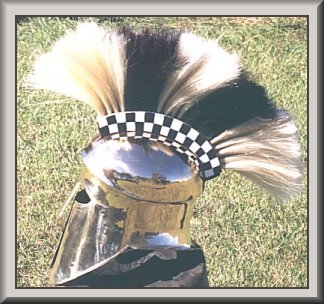
|
"To be sure, carved in wood, high on the chair, was the
helmet with crest of sleen-fur, the mark of the captain, ..." Marauders of
Gor, pg. 6
|
|
Common Helmet

|
The common Gorean helmet is also like an ancient Greek
helmet. It is made of a nearly solid metal, with a "Y" shaped slot for eyes,
nose and mouth. Many helmets are cushioned with leather. They may be crested
with sleen hair.
"Above the shield was a suspended helmet, again reminiscent of a Greek helmet,
perhaps of the Homeric period. It had a somewhat 'Y'-shaped slot for the
eyes, nose, and mouth in the nearly solid metal." Tarnsman of Gor, pg. 22
|
|
Helmet of the Wagon Peoples
|
The Wagon Peoples Helmet was a conical iron helmet fur-rimmed
a net of colorful chains dangling before the face to protect leaving only
an opening for the eyes.
"...he wore a conical, fur-rimmed iron helmet, a
net of colored chains depending from the helmet protecting his face, leaving
only holes for the eyes." Nomads of Gor, pg. 10
|
|
Northern Helmet
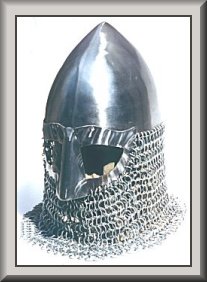
|
"The helmets of the north are commonly conical, with
a nose-guard, that can slip up and down. At the neck and sides, attached
by rings, usually hangs a mantle of linked chain. The helmet of Thorgard
himself, however, covered his neck and the sides of his face. It was horned."
Marauders of Gor, pg. 73 |
|
Knife Gauntlet
|
A pair of leather gauntlets, upon which are mounted knife
blades. Sometimes used by gladiators in arena combats. These are seldom used
as weapons of war.
"Sometimes men wrestle to the death or use the spiked gauntlets." Assassin
of Gor, pg.
|
|
Shields
Some of the lands of Gor carry shields of different styles.
The Wagon People use small, round leather shields that are commonly glossy
and lacquered whereas the Turian and Alars shields tend to be oval shaped.
Rencers use small shields of rence wicker and the shields of the natives
of the jungles near Schendi tend to be long and oval. In the Ukungu region
of the jungle, there is commonly a tuft of feathers fastened to one point
of the shield. If it is placed at the bottom of the shield it means that
you hunt animals. If it is placed at the top, then it means that you hunt
humans. The shields of the Red Savages are small, round shields made of the
hide of the kailiauk. They are inscribed with medicine signs. It is believed
that if they are unworthy or lie, their shields will fail to protect them.
The shields of Torvaldsland are circular and wooden.
|
|
Buckler
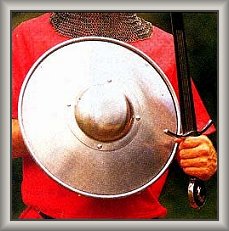
|
A small oval shield about 16 to 18 inches. While this
shield was made of steel on earth, on Gor it is, like all other shields made
of leather.
"Incidentally, Turian warriors, in order to have the opportunity to slay
a foe, as well as acquire his woman, customarily choose as the weapon of
combat in these encounters, buckler and dagger, ax and buckler, dagger and
whip, ax and net, or the two daggers, with the reservation that the quiva,
if used, not be thrown. Kamrak, however, appeared adamant on the point. "The
sword," he repeated." Nomads of Gor, pg. 124
|
|
Common Shield
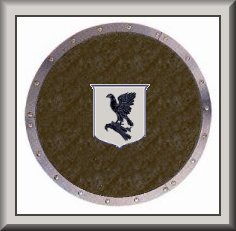
|
The most common Gorean shield is a round shield like
those used by the ancient Greeks. The shield is made of concentric, generally
about 24 to 36 inches in diameter, overlapping layers, usually seven, of
hardened leather riveted together and bound with hoops of brass. It is fitted
with a double sling for carrying on the left arm. It is usually painted boldly
with a device to identify your city. Only exiles and outlaws have no shield
markings. A shield requires skill to use it properly and this is likely one
reason why the Priest-Kings permit their use.
"The round shield, concentric overlapping layers of hardened leather riveted
together and bound with hoops of brass, fitted with the double sling for
carrying on the left arm, was similarly unmarked. Normally the Gorean shield
is painted boldly and has infixed in it some device for identifying the bearer's
city." Outlaw of Gor, pg. 21
|
|
Turian Shield
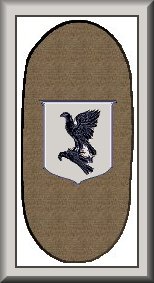
|
An oval shield about 24 inches by 36 inches, this shield
is also constructed of hide like it's round cousin.
" The morning sun flashed from their helmets, their long tharlarion lances,
the metal embossments on their oval shields, unlike the rounded shields of
most Gorean cities." Nomads of Gor, pg. 113
|
|

Axes |
|
Torvaldslander Battle Axe
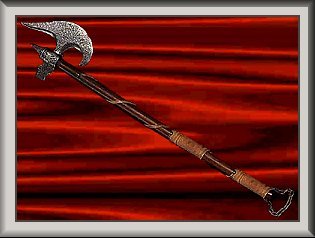
|
This weapon is described as a single-bladed axe of steel,
with a blade of anywhere from 8 to 14 inches in width, and is mounted on
a thick wooden handle usually has a wrist thong attached to the end the handle,
which enables it to be more easily retained during combat.
This weapon first appears in the series in book #8, Marauders of Gor.
|
|
Torvaldslander Great Axe
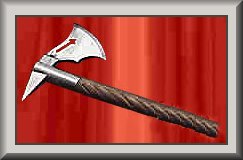
|
Is a great, curved, single bladed axe of hardened iron
with a blunt hammer-like head, it is carried in a leather loop hung from
a broad leather belt worn from the left shoulder to the right hip. It is
fastened there by a hook, that the weight of the ax will not turn the belt,
which fits into a ring in the Master belt
|
|
Single Blade Axe
|
I knew this man of Torvaldsland only by reputation. He
was a rover, a great captain, a pirate, a trader, a warrior. It had been
he, and his men, who had freed Chenbar of Tyros, the Sea Sleen, from a dungeon
in Port Kar, breaking through to him, shattering his chains with the blunt
hammer like backs of their great, curved, single-bladed axes. He was said
to be fearless, and mighty, swift with sword and axe, fond of jokes, a deep
drinker, a master of pretty wenches, and a madman. But he had taken in fee
from Chenbar Chenbar's weight in the sapphires of Shendi. I did not think
him too mad." Marauders of Gor, page 26
|
|

|
|
Bola
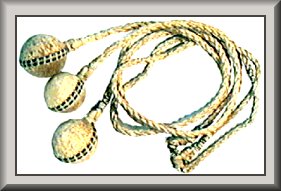
|
A favorite weapon of the Wagon People. Fighting mainly
from the backs of their kaiila, they become very proficient with the use
of this weapon. used for both hunting and battle .
"Slowly, singing in a guttural chant, a Tuchuk warrior song, he began to
swing the bola. It consists of three long straps of leather, each about five
feet long, each terminating in a leather sack, which contains, sewn inside,
a heavy, round metal weight. It was probably developed for hunting the tumit,
a huge, flightless carnivorous bird of the plains, but the Wagon Peoples
use it also, and well, as a weapon of war. Thrown low the long straps, with
their approximate ten-foot sweep, almost impossible to evade, strike the
victim and the weighted balls, as soon as resistance is met, whip about the
victim, tangling and tightening the straps. Sometimes legs are broken. It
is often difficult to release the straps, so snarled do they become. Thrown
high the Gorean bola can lock a man's arms to his sides; thrown to the throat
it can strangle him; thrown to the head, a difficult cast, the whipping weights
can crush a skull. One entangles the victim with the bola, leaps from one's
mount and with the quiva cuts his throat." Nomads of Gor, pg. 24
|
|

Bows and arrows |
|
Crossbow
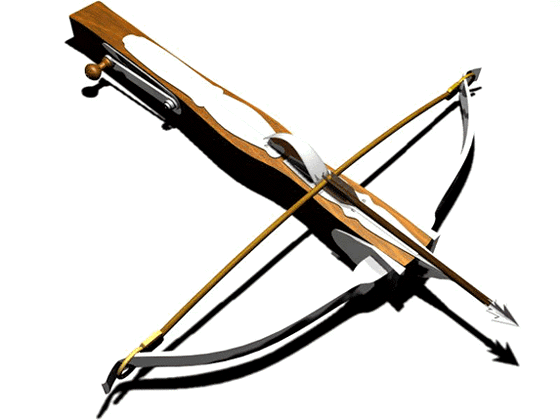
|
A standard infantry weapon of Gor. It consists of a heavy,
flexible bow of tempered steel, 18" across (when drawn), mounted on a heavy
wooden stock about two feet long, with a trigger mechanism built into the
shaped handle. It can use several types arrows (quarrels) of spiked, smooth
tipped or broad bladed quarrels, striking with enough force to penetrate
wooden walls, doors or human bodies with relative ease. It has an effective
range of approximately 150 yards. Slow to reload, it is commonly redrawn
through use of a "goat's-foot" hook or a cranequin (bow crank). Quarrels,
or "bolts," are carried by the user in a belt-case or quiver.
First appears in book #1, Tarnsman of Gor, and is afterwards seen often
throughout the series.
|
|
Crossbow Cavalry
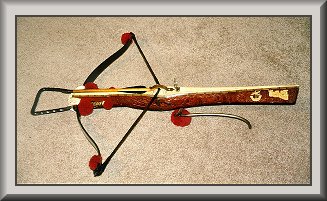
|
Much like the larger crossbow, instead of possessing
a metal bow, it has a much lighter bow of wood or horn. Slightly smaller
in size, it is still a powerful weapon. It is equipped with a metal stirrup
at the firing end, allowing it to be more quickly restrung while on the back
of a tarn or kaiila
"The cavalry crossbow does have an iron stirrup in which the rider, without
dismounting, may insert his foot, thus gaining the leverage necessary for
drawing the cable back with both hands. If the rider is right handed he usually
inserts his right foot in the stirrup and leans to the right in drawing the
cable; this procedure is reversed, of course, usually, if the rider is left
handed. While this procedure permits the rider to reload without dismounting
and tends to improve, at some cost to striking power, the bow's rate of fire,
it still provides, in my opinion, no adequate compensation for the loss of
rapidity of fire. I think it not unlikely that the red savage could discharge
three to five shafts in the time a single quarrel could be set in the clumsier
weapon. In my opinion, if the crossbow, of the lighter, more quickly loading
type, had proved to be a superior missile weapon in the typical combats practiced
in the Barrens the red savages would have had recourse either to it, or to
something analogous to it. But they have not." Savage of Gor, pg. 96
|
|
Crossbow, standard
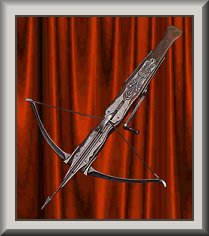
|
A standard weapon of Gor. It consists of a heavy, flexible
bow of tempered steel, 18" across mounted on a heavy wooden stock about two
feet long, with a trigger mechanism at the bottom. Striking with enough force
to penetrate wooden walls, doors or human bodies with relative ease. It has
an effective range of approximately 150 yards. Slow to reload, it is commonly
redrawn through use of a goat's-foot hook or a crank.
"The crossbow is the assassin's weapon, par excellence; further, it might
be mentioned that, although it takes longer to set the crossbow, a weaker
man, with, say, his belt claw or his winding gear, can certainly manage to
do so; accordingly, for every man capable of drawing a warrior's long bow
there will be an indefinite number who can use the crossbow; lastly, at shorter
distances, the crossbow requires much less skill for accuracy than the long
bow." Raiders of Gor, pg. 2
|
|
Great (Peasant) Bow

|
A non - recurved long bow made from the wood of the ka-la-na
tree or sometimes of temwood. Unstrung it is over six feet in length, and
can require a pull of up to 120 lbs. The bowstring itself is usually made
of hemp or sinew lashed with silk thread. The arrows of the bow are temwood,
and fletched with the feathers of the vosk gull. Each such arrow is approximately
three feet in length, and can be tipped with several different types of
arrowheads; of these, the flight tip (a long narrow three-sided metal spike
designed for extreme penetration) and the sheaf tip (a wide double or triple
edged blade designed to inflict maximum tissue damage upon impact) are the
most common. It is commonly carried slung or strapped over the shoulder of
the archer when not in use, and is accompanied by a belt or shoulder quiver
containing forty (or more) arrows. Its use requires the archer to wear a
bracer of thick leather upon the forearm of his bow arm, and to use an archer's
glove or leather finger tab to protect his hands and arm from the string
when fired.
The bow is not commonly favored by Gorean warriors, but all must respect
it. It is the height of a tall man; its back, away from the bowman, is flat;
its belly, facing the bowman, is half-rounded; it is something like an inch
and a half wide and an inch and a quarter thick at the center; it has
considerable force and requires considerable strength to draw; many men,
incidentally, even some warriors, cannot draw the bow; nine of its arrows
can be fired aloft before the first falls again to the earth; at point-blank
range it can be fired completely through a four-inch beam; at two hundred
yards it can pin a man to a wall; at four hundred yards it can kill the huge,
shambling bosk; its rate of fire is nineteen arrows in a Gorean Ehn, about
eighty Earth seconds; and a skilled bowman, but not an extraordinary one,
is expected to be able to place these nineteen arrows in one Ehn into a target,
the size of a man, each a hit, at a range of some two hundred and fifty yards.
Yet, as a weapon, it has serious disadvantages, and on Gor the crossbow,
inferior in accuracy, range and rate of fire, with its heavy cable and its
leaves of steel, tends to be generally favored. The long bow cannot well
be used except in a standing, or at least kneeling, position, thus making
more of a target of the archer; the long bow is difficult to use from the
saddle; it is impractical in close quarters, as in defensive warfare or in
fighting from room to room; and it cannot be kept set, loaded like a firearm,
as can the crossbow;... Raiders of Gor, pg. 2 |
|
Short Bow
|
About four feet long there are a number of varieties of
this bow on Gor. The best known, most popular is of course the horn bow of
the Wagon People. The Red savages use one made of layered wood banded together
as do the northern peoples, these are often called ship bows. While not as powerful
as the long bow or cross bow they have a big advantage over the long bow
in their ability to be used in tight places. Their rate of fire is much faster
than the crossbow. A Wagon Person can fire twenty arrows in half an Ehn.
The Red Savages use a small bow and there is no other bow that can match
its rate of fire. It is very maneuverable and can be easily concealed.
"Kamchak was a skilled instructor in these matters and, freely, hours at
a time, until it grew too dark to see, supervised my practice with such fierce
tools as the lance, the quiva and bola. I learned as well the rope and bow.
The bow, of course, small, for use from the saddle, lacks the range and power
of the Gorean longbow or crossbow; still, at close range, with considerable
force, firing rapidly, arrow after arrow, it is a fearsome weapon." Nomads
of Gor, pp. 66-67 |
Arrow, Sheaf and Flight

|
"The Gorean sheaf arrow is slightly over a yard long,
the flight arrow is about forty inches in length. Both are metal piled and
fletched with three half-feathers, from the wings of the Vosk gulls.
Mixed in with the arrows were the leather tab, with its two openings for
the right forefinger and the middle finger, and the leather bracer, to shield
the left forearm from the flashing string." Raiders of Gor, page 68
|
|

|
|
Daggers

|
Take many forms, depending upon the needs and whims of
their users, and such weapons are the most common form of side-arm used on
Gor. Daggers are worn openly in a belt-sheath or concealed beneath one's
clothing, often strapped to the wrist beneath the owner's sleeve, tucked
into the collar behind the neck, or hidden in a boot. Used by many freewomen
as a personal means of self-defense.
|
|

|
|
Garrote
|
This is usually armed with wire to cut a throat. There
are two wooden handles at the ends so you can hold it safely. There is also
a version without the wire that can be used to capture people without injuring
them. One such variety is the girl-capture chain. It has a narrow golden
chain that will choke someone without cutting their throat. You can adjust
the chain by spinning one of the wooden handles.
|

|
|
Goad, tarn or slave
|
While not truly weapons, the tarn goad can stun. The slave
goad on the other hand can kill.
"He entered my apartment, carrying a metal rod about two feet long, with
a leather loop attached. It had a switch on the handle, which could be set
for two positions, on and off, like a simple torch. `What is it?' I asked.
'A tarn-goad,' he replied. He snapped the switch in the barrel to the "on"
position and struck the table. It showered sparks in a sudden cascade of
yellow light, but left the table unmarked. He turned off the goad and extended
it to me. As I reached for it, he snapped it on and slapped it in my palm.
A billion tiny yellow sparks, like pieces of fiery needles, seemed to explode
in my hand. I cried out in shock. I thrust my hand to my mouth. It had been
like a sudden, severe electric charge, like the striking of a snake in my
hand. I examined my hand; it was unhurt. 'Be careful of a tarn-goad,' said
the Older Tarl. 'It is not for children." Tarnsman of Gor, pg. 50
"He scrambled to His feet, his face a mask of hate, looked about, saw the slave
goad, ran to it and whipped it from the wall. I did not pursue him, not wanting
to kill him. He turned and I saw, in almost one motion of his finger, the
goad switch go to on, the dial rotate to the kill point. Then crouching,
the goad blazing in his hand, he approached me warily." Assassin of Gor, pg.
260
|

|
|
Harpoon

|
A spear fitted with a barbed head and used with line
attached to assist in retrieval.
"I grasped the long harpoon. It was some eight feet in length, some two and
a half inches in diameter. Its major shaft was of wood, but it had a foreshaft
of bone. In this foreshaft was set the head of the harpoon, of bone, drilled,
with a point of sharpened slate. Through the drilled hole in the bone, some
four inches below the slate point and some four inches above the base of
the head, was passed a rawhide line, which lay coiled in the bottom of the
boat. As the hole is drilled the line, when it snaps taut, will turn the
head of the harpoon in the wound, anchoring it. Beasts of Gor, pg.
|

|
|
Knives
The Hook knife, with its small, thick curved blade, is
used in some gladiatorial combats. The Sleen knife is a common weapon of the
panther girls. There is a type of throwing knife, used in Ar, which is tapered
on one side. It is designed for killing. All Tarn Keepers carry such a knife.
The panga is a two-foot long, heavy, curve-bladed bush knife. The whip knife
is a delicate weapon, unique to Port Kar. It is a whip but set into its final
eighteen inches, arranged in sets of four, are twenty thin, narrow blades.
Their tips vary. Some have a double-edged blade of seven to eight inches
at the tip while others have a stunning lead. Other similar weapons include
the curved dagger of Schendi and the Turian dagger. Some people use a sheath
to hide a dagger in their sleeve.
|
|
Hook knife
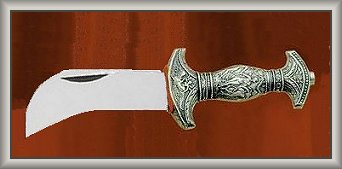
|
The hook knife is very similar to the utility knife found
on earth. A short, wide blade, narrowing to a downward curve, ending in a
sharp point. When used in recreational spars, the knife remains sheathed
so as not to injure the opponent. The knife is seldom used for other than
stadium fighting, weather sheathed or not.
"Both were stripped to the waist. The hair of both was bound back with a
band of cloth. Each carried, sheathed, a hook knife. The edges of the sheath
were coated with a bluish pigment." Assassin of Gor, pg. 86
|
|
Killing knife
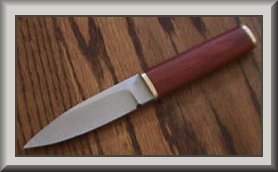
|
A throwing knife, used by the Caste of Assassins. It
is much smaller than the quiva, approximately six to eight inches in length,
and its blade is tapered on only one side. Sometimes used in conjunction
with poison, though trained Assassins typically disdain the use of poison.
It is rarely used in hand-to-hand combat, designed primarily to be thrown
at the body of an unsuspecting victim.
"It was a throwing knife, of a sort used in Ar, much smaller than the southern
quiva, and tapered on only one side. It was a knife designed for killing.
Mixed with the blood and fluids of the body there was a smear of white at
the end of the steel, the softened residue of a glaze of kanda paste, now
melted by body heat, which had coated the tip of the blade. On the hilt of
the dagger, curling about it, was the legend, 'I have sought him. I have
found him.' It was a killing knife. 'The Caste of Assassins?' I had asked.
'Unlikely,' had said the Older Tarl, 'for Assassins are commonly too proud
for poison.'" Assassin of Gor, pg. 42
|
|
Quiva

|
The quiva is a balanced saddle knife of the Wagon Peoples
of the prairies. It is about a foot in length, double edged, and tapers to
a daggerlike point. The quiva is used more as a missile weapon than a
hand-to-hand weapon. It is not necessary to throw it hard as its sharpness
and weight do the work for you. Most quivas are made in Ar and sold in sets
of seven, as there are seven sheaths in the kaiila saddles of the Wagon Peoples.
The quivas are almost always kept in their saddle sheaths. The quivas are
also made differently for each tribe of the Wagon Peoples. Despite the fact
that they are manufactured in Ar, the quiva is almost exclusively a weapon
of the Wagon People. In the novels, Tarl Cabot is the only non-Wagon Person
who ever used a quiva. Tarl even creates a carnival act out of the use of
the mysterious quivas, a weapon known to few. The use of quivas outside of
the Wagon Peoples should be rare. It is also rumored to be carried by most
Free Women and many Warriors of different cities.
|
|
Sleen knife
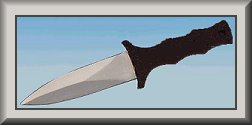
|
This is a broad bladed, flat, double edged utility knife
equipped with a simple stubby cross guard and unadorned grip . Rather than
tapering down to a needle like point like the quiva it's point is more
rounded.
"I saw Sheera, standing knee deep in the water, near the beach. She had now
thrust her sleen knife into its belt sheath. She was a strongly bodied girl.
The sun made the chains and claws at her throat gleam. 'Return again' she
called, 'perhaps we will have more men to sell you.'" Hunters of Gor, pp.
32-33
|
|
Tarn knife
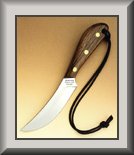
|
This is a short bladed, single edged utility knife typically used by tarnsmen
and generally included among their saddle equipment. Some knives are designed
so that the blade folds into the handle for safety when not in use. Often
equipped with a lanyard so that it may be lashed to the tarnsman's saddle
or belt.
"I looked across to Menicius of Port Kar. His eyes darted from mine. He bent
over the neck of Quarrel. I saw that He had been given another knife, a Tarn
knife, of the sort carried by riders. In His right hand, ready, there was
a Tarn goad." Assassin of Gor, pg. 363
|
|
Whip Knife
|
The whip knife, unique to Port Kar, is a delicate weapon. It is a whip, but
set into its final 18 inches, on 5 tassels or strips of hide, arranged in
sets of four, are twenty thin, narrow blades. Their tips vary. Some have
a double-edged blade of seven to eight inches at the tip while others have
a stunning lead.
"The important point, however, in the circumstances was that Kamras had proposed
the sword as the weapon of his encounter with Kamchak, and poor Kamchak was
almost certain to be as unfamiliar with the sword as you or I would be with
any of the more unusual weapons of Gor, say, the whip knife of Port Kar or
the trained varts of the caves of Tyros." Nomads of Gor, pg. 124
|

|
|
Poison
|
Poison is prohibited by the Warrior and Assassin Codes.
It is most commonly a woman's weapon. Some methods of holding poison include
fang rings and poison teeth. With a fang ring, you fold your hand into a
fist and use your thumb to press a switch. That activates a fang of hollow
steel to spring up, the fang holding some type of poison. The teeth are most
common in Turia and usually contains ost venom. Ost venom and kanda paste
are two of the most commonly used poisons. Ost venom can be made into a powder
to poison a drink. Kanda paste can be applied to a weapon. It can also be
added to liquids and has been used to poison reservoirs. Free women often
conceal poisoned daggers or needles in their clothing. This can make it dangerous
to try to collar a free woman. Gorean poisons are quite deadly and little
is said in the novels about antidotes or preventative measures. For example,
the bite of an ost leads to death within seconds. That gives one little time
to prevent one's death. It is likely that the potency of the poison is lessened
to some degree when it is removed from the ost and used as a powder or in
a fang ring. You are likely getting a smaller dose of the poison or a more
diluted form than from an actual bite. Antidotes could potentially exist
though they are not explicit in the books.
|

|
|
Rope

|
Coiled rope of braided boskhide
"Kamchak was a skilled instructor in these matters and, freely, hours at
a time, until it grew too dark to see, supervised my practice with such fierce
tools as the lance, the quiva and bola. I learned as well the rope and bow."
Nomads of Gor, pp. 66-67
|

Spears
|
|
Common Gorean Spear
|
The typical Gorean spear is approximately seven feet
in length, with a fitted wooden handle up to two inches thick, capped by
a leaf-shaped, tapering head eighteen inches in length. The handle itself
is usually made from ka-la-na wood, and banded with metal near the juncture
of the spear-head socket to prevent the handle from shearing when
thrown.
|
|
Lance
|
The common lance is about eleven feet long and has a
very narrow, lanceolate-shaped blade. The shaft is usually tem wood that
is black, supple and strong. There are several varieties of lances. The Wagon
Peoples use a kaiila lance, which was designed for kaiilaback and used in
hunting and war. Hunting lances are longer, heavier and thicker than a war
lance. Hunting lances are usually undecorated, except for maybe a knot of
prairie fleer feathers. Its point is longer and narrower as it must strike
deeply to pierce the heart of a kailiauk.
Alars often use such lances and use them couched due to their size. Stabbing
lances, which are smaller and thicker, are used by some pedestrian nomads.
The tarn lances used by the red savages are very similar to the Kaiila lance,
though it is longer and more slender. Even the red hunters use hunting lances.
|
|
Kaiila Lance
|
The Wagon Peoples use a kaiila lance, which was designed
for kaiilaback and used in hunting and war. The kaiila lance is not couched,
but carried in the right fist. It is flexible and light. It is used for
thrusting, unlike the battering ram effect of European lances. It can almost
be as delicate and swift as a saber. It may even have a rider hook under
the point to help dismount opponents.
|
|
Tarn Lance
|
Similar
to the war lance, except that it is longer and
more slender, easier use from tarnback.
"The tarn lance, it might be mentioned, as
is used by the red savages who have mastered the tarn, is, in size and
shape, very similar to the kaiila lance. It differs primarily in being
longer and more slender." Savages of Gor chapter 1
|
|
Tharlarion lance

|
A thick spear, approximately ten to fourteen feet long. It has a lanceolate
spear tip that attaches to a thick shaft ... at the thickest part the shaft
of the lance is about four inches in width and is often fluted to lighten
it. Usually carried when on the tharlarion, couched beneath the right arm
of the user, the lance itself crossing over and above the neck of the mount,
often supported by a lance-rest which is either attached to the saddle or
worn strapped to the user's chest. Can also be thrown, though not designed
for it.
"In a minute the rider appeared in view - a fine, bearded warrior with a
golden helmet and a tharlarion lance." Tarnsman of Gor, pg. 115
|
|
Trident

|
The three-pronged spearing fork used by fishermen and sailors of the islands
of Gor. Can be utilized both as a thrusting weapon and as a throwing weapon.
It is also used, in conjunction with a hooked net, in various gladiatorial
arenas throughout Gor. (rentiri) It is briefly described as being approximately
seven feet in overall length, with prongs of 10" inches or more. Often used
with a line attached, for retrieval should it be thrown.
"I could use some paga," said he. He had purchased the net in the morning
with a trident, the traditional weapons of the fisherman of the western shore
and the western islands." Raiders of Gor, pg. 112 |
|
War spear

|
One of the most common weapons on Gor, its versatility makes it a very popular
weapon, used for fighting and hunting.
"The spear was a typical Gorean spear, about seven feet in height, heavy,
stout, with a tapering bronze head some eighteen inches in length. It is
a terrible weapon and, abetted by the somewhat lighter gravity of Gor, when
cast with considerable force, can pierce a shield at close quarters or bury
its head a foot deep in solid wood. With this weapon groups of men hunt even
the larl in its native haunts in the Voltai Range, that incredible pantherlike
carnivore which may stand six to eight feet high at the shoulder." Outlaw
of Gor, pg. 21
|

|
|
Staff
|
This is also primarily a peasant weapon. It is commonly
about six feet long and two inches wide. A skilled combatant with a staff
can hold his own against most warriors with a sword. Such a staff can be
quite agile and nimble in skilled hands. The staff also has practical uses
such as an aid in traversing unsteady terrain or to carry suspended baskets.
Thus a peasant will often have this weapon handy.
|

|
|
Swords
Different Gorean cultures use many different types of
swords. The Alar use the spatha, a long and heavy, double-bladed sword. This
is more effective from the back of a tharlarion, a common mount of the Alars.
The Alars do use a short sword as well, called the sacramasax. This is similar
to the gladius. The men of the Torvaldsland also use a long sword. The scimitar
is commonly used in the Tahari. It is a long, curved blade that is effective
from the back of a kaiila. There is even a two-handed variety called the
scimitarus that is effective from tharlarion back. The saber is almost unknown
on Gor as it is regarded as too long and clumsy for the close, sharp combat
common to Gorean warriors. The Wagon Peoples rarely use swords. Warriors
also take care of their own swords, not relying on others to do so. They
will be the only ones to hone and oil their blades.
|
|
Non-Existent Swords:
A number of Earth swords do not exist in the Gorean novels.
Rapiers, epees and foils do not exist. Such fencing is not a normal part
of Gorean combat. Katanas and other such oriental swords also do not exist.
Though there are Orientals on Gor, there is no evidence that there is a specific
oriental culture that would create such weapons. Other types of European
weapons such as broadswords, claymores and main-gauches also are foreign
to Gor.
|
|
Longsword
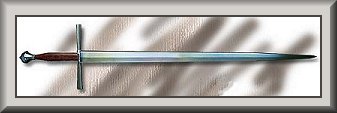
|
The Long sword is commonly used by the warriors of
Torvaldsland. Approximately 36 inches in length, the forging of these "long
swords" follows the pattern of the swords in the Damascus style. In this
method, many billets of steel, both hard (high carbon) and soft or flexible
(tool) steel are beaten together under heat and folded back upon itself and
beaten flat again. This is repeated many times. This folding creates a blade
with both a tremendous amount of flexibility and also one that is virtually
unbreakable. It also, when treated with a mild acid solution, reveals the
pattern formed by the layers of the different steels This pattern is different
from blade to blade and gives the sword it's unique appearance. This blade
is used as a slashing weapon ... often it is used to batter an opponents
shield to bits ... It is carried in a belt-scabbard or strapped across its
user's back over his right shoulder. Most long swords are “named”
blades .
"He wore beneath his cloak of yellow wool, and a great belt of glistening
black, with a gold buckle, to which was attached a scabbard of oiled, black
leather; in this scabbard was a sword, a sword of Torvaldsland, a long sword,
with a jeweled pommel, with double guard." Marauders of Gor, pg. 172
|
|
Scimitar
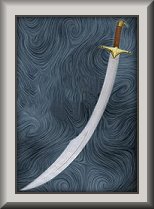
|
A long curved sword, used either one-handed or with
two-hands, depending upon the situation. Forged in the Damascus manner, it
has a wickedly curved, single-edged blade, honed to razor-sharpness. Even
a light stroke of a Tahari scimitar will pass effortlessly through the flesh,
leaving a carved mark 1/4" inch deep in the bone beneath. The overall blade
length is perhaps thirty or more inches, with an eight inch long "false-edge"
across the back of the tip, for backhanded slashes. Used one handed from
kailla back it is incredibly deadly; used two-handed upon the ground it is
equally terrifying. The sword of choice in the Tahari, This razor sharp,
curved blade is generally about 30 to 36 inches long. The back 3-8 inches
has a false edge that can be sharpened for back slashes. Like the longsword
it has better reach, which can be an advantage when mounted upon the kailla.
Slower to draw and slower to wield than the shortsword it is still a deadly
weapon.
"Djellabas and burnooses, sleeveless, hooded desert cloaks, were being sold
in another stall. The burnoose can, as the djellaba cannot, because of the
sleeves, be thrown back, freeing the arms. One who rides the swift kaiila,
who handles the scimitar and lance, chooses the burnoose." Tribesman of Gor,
pg. 50
|
|
Shortsword
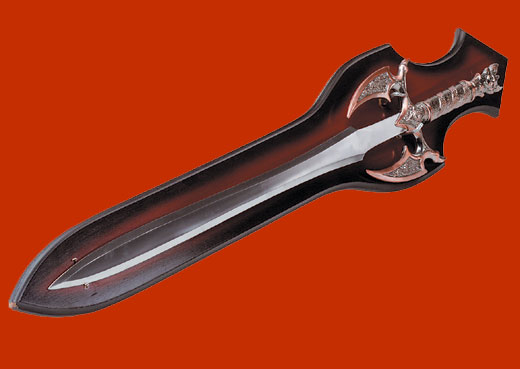
|
The basic weapon of all warriors of Gor. Approximately
twenty to twenty-two inches in length from hilt tip to blade tip, the blade
is doubled-edged, and leaf shaped ... narrower at the hilt base and then
widening to a width of three or four inches and then descending to a curved
and pointed tip. The grip is generally either of polished wood or leather
covered wood, with an oval cross-guard. The Gorean short sword is hand forged
of light carbon steel. The leaf shaped blade is ideal for thrusting. Perfect
for close combat, its point giving it excellent armor penetrating properties.
It is generally carried, in a sheath slung over the left shoulder by means
of a leather harness, but may also be worn at the hip.
Another style of short sword is the gladius. It is derived from the Earth
sword of the same name. it is of Spanish origin and was widely used by the
ancient Romans. It is about twenty to twenty-two inches long, double-edged,
and well balanced. Its blade is so sharp that it will slice a piece of silk
dropped down on it. The gladius is heavy enough to have a considerable striking
force in saberlike trajectories but light enough to have some of the swiftness
and play of a foil. The gladius is maneuverable enough to work its way behind
the guard of a longer, heavier weapon. There are other benefits of a short
sword over a longer blade as well. A gladius can clear the scabbard a fraction
earlier and that can be vitally important. The short blade can also be moved
with greater swiftness than a long blade. It allows you to work close to
your opponent. If a swordsman with a longer weapon can not finish a battle
in the first thrust or two, he will generally lose the battle. The gladius
though is very ineffective, due to its smaller size, when used from the back
of a mount such as a tharlarion, tarn or Kaiila.
"I supposed one of the reasons for the short blade was that it could clear
the sheath a fraction of a second before a longer blade. Another advantage
was that it could be moved with greater swiftness than a longer blade. The
primary advantage I supposed was that it allowed the Gorean warrior to work
close to his man. The brief reach of the blade tended to be more than compensated
for by the rapidity with which it might be wielded and the ease with which
it might work beneath the guard of a longer weapon. If the swordsman with
a longer weapon could not finish the fight in the first thrust or two he
was a dead man." Priest-Kings of Gor, pg 174 |

|
|
War Club
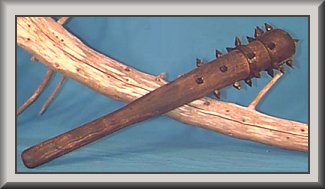
|
A carved, shaped club of wood or bone, often mounted
with stone or metal projections such as sharp pieces of flint, nails or knife
blades driven into the wood . This weapon is about two or three feet in length.
Used mostly by the Red Savages.
"Grunt carried similar articles but he, as well, as I had not, carried such
items as long nails, rivets, hatchets, metal arrowheads, metal lance points,
knife blades and butcher knives. The knife blades and long nails are sometimes
mounted in clubs." Savages of Gor, pg. 145
|

Whips |
|
Bosk Whip
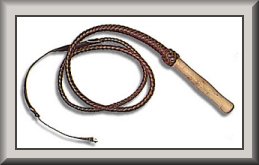
|
Much like an earth bull whip. Made of Bosk hide plaited
together. This whip can be anywhere from 8 to 12 feet long.
"Beside him, coiled, perhaps as a symbol of power, lay a bosk whip" Nomads
of Gor, pg. 43
|
|
Kurt Whip
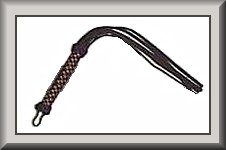
|
A slave whip with five broad, pliant straps. Each strap
is about two and a half feet long and one and a half inches wide. The handle
is eighteen inches long. Though it may leave a welt, it doesn't permanently
mark a victim.
"A stout whip, with a long handle, which might be wielded with two hands,
and five dangling, soft, wide lashing surfaces, each about a yard long."
Kajira of Gor, pg. 83
|
|
Snake Whip
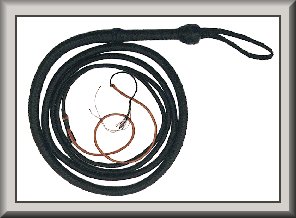
|
A single-bladed whip, weighted, of leather. It is about
eight feet long and half an inch to one inch thick. It is sometimes set with
tiny particles of metal. It is a deadly whip and can easily strip flesh from
the body. It can kill a Man.
"Heavy coil, laced with wire and flecks of iron. Used primarily on male
slaves/captives." Beasts of Gor, pg. 161
|
  
|
































